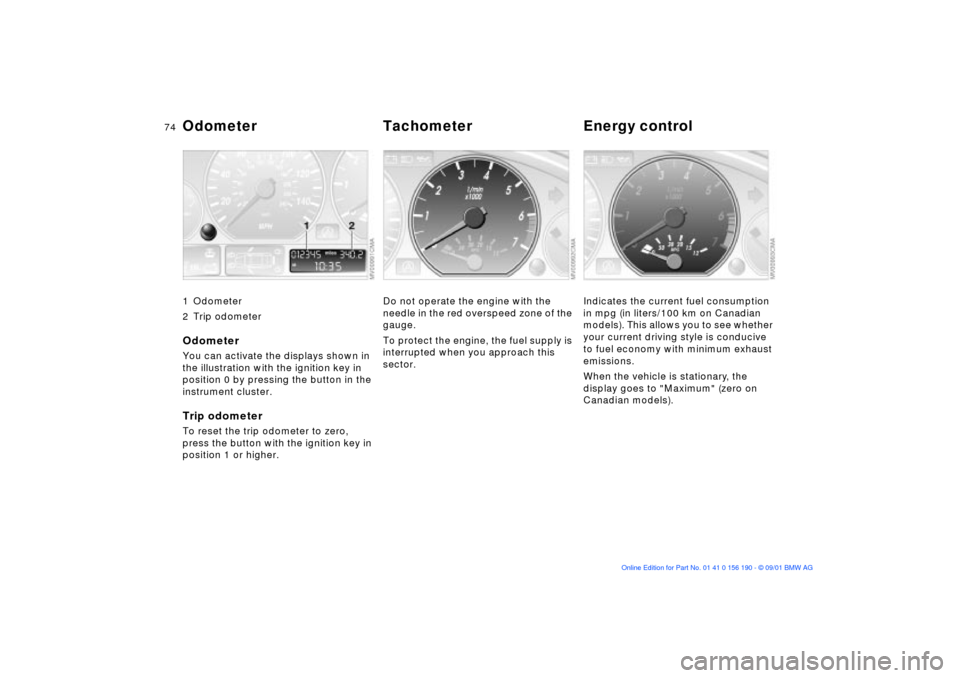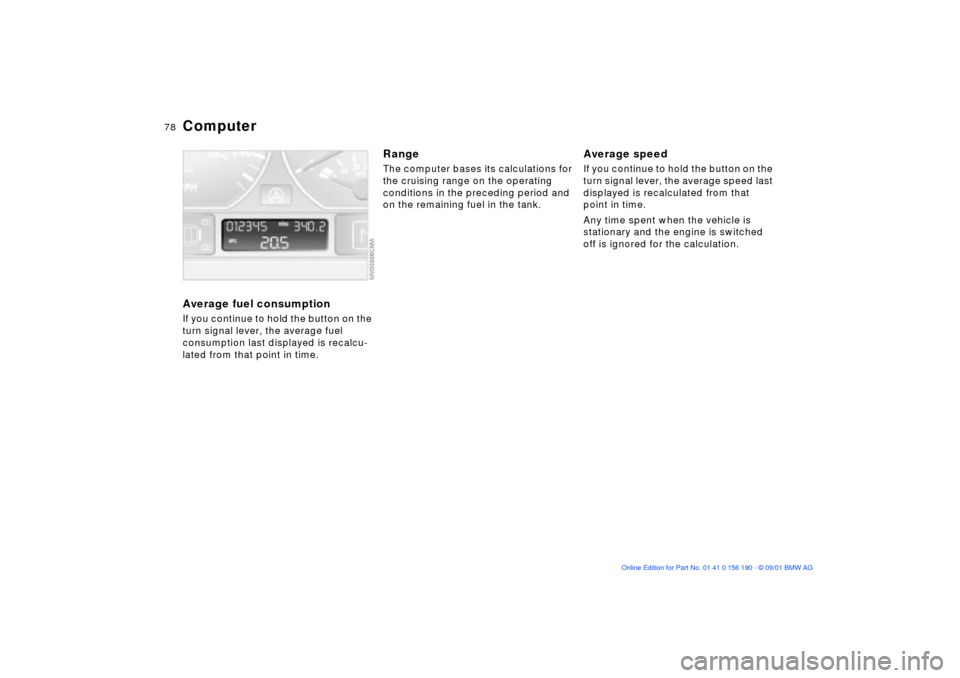2002 BMW 330Ci CONVERTIBLE fuel consumption
[x] Cancel search: fuel consumptionPage 74 of 159

74n
Odometer Tachometer Energy control 1 Odometer
2 Trip odometerOdometer You can activate the displays shown in
the illustration with the ignition key in
position 0 by pressing the button in the
instrument cluster.Trip odometerTo reset the trip odometer to zero,
press the button with the ignition key in
position 1 or higher.
Do not operate the engine with the
needle in the red overspeed zone of the
gauge.
To protect the engine, the fuel supply is
interrupted when you approach this
sector.
Indicates the current fuel consumption
in mpg (in liters/100 km on Canadian
models). This allows you to see whether
your current driving style is conducive
to fuel economy with minimum exhaust
emissions.
When the vehicle is stationary, the
display goes to "Maximum" (zero on
Canadian models).
Page 76 of 159

76n
Check Control ComputerWhen you turn the ignition key to posi-
tion 2, any of the following symbols may
appear to call your attention to problem
areas; the symbols remain in the
display panel until the problem is
corrected:
1 Check the low and high beams as
well as the parking lamps
2 Door open
3 Luggage compartment lid open
4 Check tail or brake lamps
When you open the driver's door after
completing a journey, an acoustic
warning signal will sound if the head-
lamps are still on.
Mode selectionFrom ignition key position 1, you can
call up information from the computer
using the button in the turn signal lever.
The information is displayed in the
instrument cluster. By pressing the
button briefly toward the steering
column, you can call up a new function
for display.
The displays appear in the following
order:
Time of day, outside temperature,
average fuel consumption, cruising
range, average vehicle speed.
When the ignition key is turned to posi-
tion 1 or higher the last active setting is
displayed.
ClockIf you wish to have a permanent time
display, you can make this setting in the
radio display (refer to the Radio
Owner's Manual).
You can set the clock and the time
display in the car radio as follows.
Page 78 of 159

78n
ComputerAverage fuel consumptionIf you continue to hold the button on the
turn signal lever, the average fuel
consumption last displayed is recalcu-
lated from that point in time.
RangeThe computer bases its calculations for
the cruising range on the operating
conditions in the preceding period and
on the remaining fuel in the tank.
Average speedIf you continue to hold the button on the
turn signal lever, the average speed last
displayed is recalculated from that
point in time.
Any time spent when the vehicle is
stationary and the engine is switched
off is ignored for the calculation.
Page 105 of 159

105n
OverviewControlsMaintenanceRepairsDataIndex
Roof-mounted luggage rack for the hardtop
*
A special roof-rack system is available
as an optional extra for your BMW.
Please observe the precautions
included with the installation instruc-
tions.AnchoragesAccess to the anchorages:
To fold up the covers (arrow), please
use the tool which is provided with the
roof-rack system.Loading and driving notesRoof-mounted luggage racks raise the
center of gravity of the vehicle when
they are loaded. For this reason, they
exercise a major effect on the vehicle's
handling and steering response.
You should therefore always remember
not to exceed the approved roof load
capacity, the approved gross vehicle
weight or the maximum axle loads
when loading the rack. These weights
are listed under Technical Data on
page 146.
Make sure that the load is not too bulky,
and attempt to distribute it evenly.
Always load the heaviest pieces first (on
the bottom). Make sure that no objects
will be in the way when the luggage
compartment lid is opening or closing.
Secure the roof luggage correctly and
securely to prevent it from shifting or
being lost during driving (danger to
following traffic).
Drive smoothly and avoid sudden
acceleration or braking. Do not corner
at high speeds.
The roof-mounted luggage rack and the
roof load increase the aerodynamic
resistance: increased fuel consumption
and additional stress on the vehicle's
body are the result.
Page 121 of 159

121n
OverviewControlsMaintenanceRepairsDataIndex
Engine oilChecking oil level1. Park the vehicle on a level surface
2. Switch the engine off after it has
reached normal operating tempera-
ture
3. After approx. 5 minutes, pull the
dipstick out and wipe it off with a
clean lint-free cloth, paper towel, or
similar material
4. Carefully push the dipstick all the
way into the guide tube and pull it
out again
5. The oil level should be between the
two marks on the dipstick.
As with fuel economy, oil consumption
is directly influenced by your driving
style and vehicle operating conditions.
The oil volume between the two marks
on the dipstick corresponds to approx.
1.1 US quarts (1 liter). Do not fill beyond
the upper mark on the dipstick. Excess
oil will damage the engine.
Adding engine oilWhile you should wait until the level has
dropped to just above the lower mark
before adding oil, you should never
allow the oil level to fall below this
mark.
BMW engines are designed to
operate without oil additives; the
use of additives could lead to damage
in some cases. This is also true for the
manual transmission, the automatic
transmission, the differential, and the
power steering system.<
Recommendation: have the oil changed
at your BMW center.
Page 150 of 159

Everything from A to ZA
ABS (Antilock Brake
System)19, 109
Access to the rear51
Accessories10
Activated-charcoal filter96
Adaptive Transmission
Control (ATC)68
ADB (Automatic Differential
Brake)81
Adding
brake fluid124
coolant123
engine oil121
washer fluids120
Adjusting
electric power seats49
head restraints50
lumbar support50
mirrors55
steering wheel54
Air conditioning90
temperature setting91
Air distribution91, 94
Air nozzles90
Air outlets
ventilation90, 93 Air supply91, 94
Airbags18, 56
sitting correctly48
Alarm system28, 36
Antifreeze and anti-
corrosion agents123
disposal123
Antilock Brake System
(ABS)19, 109
Anti-theft system28, 29, 32
Aquaplaning109
Armrest99
ASC+T (Automatic Stability
Control plus Traction)80
Ashtray
front100
rear101
ATC (Adaptive Transmission
Control)68
Attach vehicle vacuum
cleaner101
AUC (Automatic recircu-
lated-air control)95
Automatic climate
control93, 94
Automatic cruise control72 Automatic Differential Brake
(ADB)81
Automatic dimming feature,
mirrors56
Automatic headlight
control87
Automatic recirculated-air
control (AUC)95
Automatic Stability Control
plus Traction (ASC+T)80
Automatic transmission67
Automatic transmission with
Steptronic18, 67
Average fuel
consumption78
Average speed78
Axle loads146
B
Backup lamps66
bulb replacement133
Battery139
care139
charging139
disposal139
Battery charge current
indicator17 Belts, safety52
Beverage holder100
Blower91, 94
BMW High Performance
Synthetic Oil122
BMW Maintenance
System125
BMW sports seat,
adjustment49
BMW Universal
Transmitter97
Bore144
Bottle holder, refer to
beverage holder100
Brake fluid124
disposal124
warning lamp17, 124
Brake fluid level109
Brake hydraulic system,
warning lamp17
Brake lamps
bulb replacement133
Brake pads19
A-Z
Page 152 of 159

Everything from A to ZDisplay lighting88
Displays15
Disposal
antifreeze and anti-
corrosion agents123
battery139
brake fluid124
engine oil122
Distance warning79
Door keys28
Doors
electrical malfunction31
locking and unlocking29
manual operation31
DOT Quality Grades,
tires114
Draft-free ventilation92, 95
Drive belts17
Driving notes109
DSC (Dynamic Stability
Control)81
DSC Dynamic Stability
Control19, 81
Dynamic Brake Control
(DBC)82
Dynamic Stability Control
(DSC)19, 81
E
Easy access to the rear51
Electric power seats,
adjustment49
Electric power windows38
Electrical malfunction
doors31
fuel filler door22
luggage compartment
lid33
Electrical malfunction,
closing only
fully-automatic convertible
top44
Elements of operation14
Emergency release of
luggage compartment lid
from luggage
compartment's interior34
Energy Control74
Engine and differential108
Engine compartment
essentials119
Engine coolant, refer to
coolant123 Engine data144
Engine oil
consumption121
disposal122
fluid capacity147
quality122
specifications122
viscosity122
Engine oil level121
check121
indicator19
Engine oil pressure
indicator17
Engine speed144
Engine, starting64
Engine, switching off65
Enlarging luggage
compartment35
Entering the rear51
Exterior mirrors55
F
Failure messages76
Filling capacities147
Fittings, tow starting and
towing141
Flashlight96 Flat Tire
Monitor85, 115, 138
Flat tires113, 135, 138
Floor panel, luggage
compartment35
Fog lamps88
Follow me home lamps87
Front fog lamps88
Front reading lamps89
Fuel consumption78
Fuel consumption
display75
Fuel filler door22
electrical malfunction22
manual operation22
Fuel gauge75
Fuel reserve indicator75
Fuel specifications23
Fuel tank capacity147
Fuel tank gauge75
Fuel-injection system144
Fully-automatic convertible
top42
electrical malfunction,
closing only44
manual closing44
Fuses139
Page 154 of 159

Everything from A to ZManual transmission66
Manually controlled recircu-
lated-air95
Master keys28
MFL (Multifunction steering
wheel)22
Microfilter92, 96
Mirror defrosting55
Mirror memory53
Mirrors55
Mobile phone, refer to
cellular phone100
Modifications,
technical10, 126
Motion sensor, refer to
interior motion sensor36
Mounting the roof rack110
Multifunction steering wheel
(MFL)22 O
OBD interface socket127
Odometer74
Oil
additives121
capacity147
consumption121
quality122
specifications122
viscosity122 Oil change intervals, refer to
the Service and Warranty
Information Booklet (US
models) or the Warranty
and Service Guide Booklet
(Canadian models)
Oil dipstick121
Oil filter change147
OIL SERVICE75
Onboard computer76
refer also to the "Owner's
Manual for Onboard
Computer"
Onboard tool kit130
Opening and closing
from the inside32
via the door lock31
via the remote control29
Original hand-held
transmitter97
Outside temperature
display77
P
Paint care, refer to the
"Caring for your vehicle"
manual
Park assistant79
Park Distance Control
(PDC)79 Parking aid79
Parking brake66
Parking lamps
bulb replacement131
PDC (Park Distance
Control)79
Phone, refer to cellular
phone100
Pocket light96
Power windows38
Q
Quality Grades, tires114 R
Radiator147
Rain sensor70
RDC (Tire Pressure
Monitor)83
Reading lamps
front89
rear89
Rear fog lamps
bulb replacement133
Rear lamps133
Rear reading lamps89
Rear window
defroster91, 95 Rearview mirror55
Recirculated-air mode91
Refueling22
Remote control29
Remove window
condensation92, 94
Replace windshield wiper
blades130
Replacement keys28
Replacing lamps and
bulbs130
Reporting safety defects11
Reverse66
Rollover protection
system61
Roof weight146
Roof-mounted luggage
rack105
S
Safe with safety belts48
Safety belts48, 52
seat-integrated51
Safety defects, reporting11
Safety tires115, 138
Seat heating54
Seat memory53
Seat-integrated safety belt
system (SGS)51